‘A potato peel, a piece of paper and a plastic packet’: The story of garbage
Let’s begin with a story of the journey of our junk, in a typical Indian city.
It begins when all three are thrown together into a waste bin, with many more such useless items, which have served their purpose. Early morning, at a scheduled time the ‘kachra’ man or woman comes to collect this motley bunch in a huge stained plastic bag. He drags and shoves all these onto a wheeled carriage or a hand drawn cart.
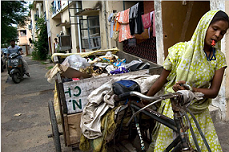
Garbage collection through hand driven cart ( Source: J Adam Huggins)
All three then join the smelly garbage collected in a ‘dhalao’, or a local garbage dump (you can invariably smell this out out, in your locality). There a bunch of ragpickers wade in, check the condition of all recyclables and carry them home in soiled bags, selling them for paltry sums.
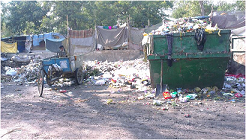
'Dhalao' for garbage collection in Delhi (Source: Sabita Kaushal)
The plastic packet, if large, is borne along with similar items to a ‘kabadi wallah’, albeit a scrap dealer to be recycled. The peel and paper are now together transported via compactors to their final destination, a landfill site, where similar biodegradable or organic items are converted into either compost, fuel (in the form of pellets or bales) or incinerated (a process of converting waste to energy). The other non biodegradable waste finds its final resting place in landfills.
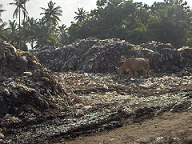
Open dumping of garbage in rural areas (Source: globalgiving.co.uk)
Most urban areas have a defined area for garbage disposal, i.e. a sanitary landfill site. In a rural setting, the waste is simply carried, peels, paper and plastic included, and dumped as piles of rubbish rotting at the edge of the village or town, polluting the groundwater and nearby water sources.
What exactly is this landfill ?
A landfill is a huge tract of land where all garbage is dumped, till it degrades completely, both biologically and physically, and until it is safe. In a scientific-waste landfill, the received waste is initially screened, manually or through a magnetic separator, and recyclable material is segregated, collected and stored separately. Bio-degradable material is processed either as compost, converted into fuel (called as refuse-derived fuel or RDF), and increasingly now is also being incinerated, to produce electricity. The left-over trash is sent to the landfill.
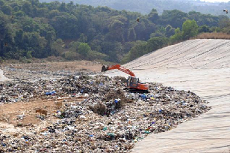
Landfill site in Mangalore (Source:thehindu.com)
A landfill is constructed by digging a large hole in the ground. This is then lined with a non-permeable lining consisting of layers of clay, plastic and gravel. These linings prevent the leachate (the liquid that drains from garbage piles and contains high concentrations of undesirable toxins) from seeping down into the soil through the garbage and polluting the groundwater under it and eventually polluting nearby water bodies too.

Leachate ponding near dumpsite in Tamil Nadu (Source: swlf.ait.ac.th)
An intricate system of pipes is embedded in the landfill, which channels this leachate into a pond where they are stored until processed and disposed of safely. These leachate collection ponds too are lined with a tough, tear-resistant plastic that prevents it from seeping out of the pond into the surroundings.
The waste is deposited in layers in the landfill and compacted with the help of heavy machinery. At the end of the day, the fresh trash is "capped," or covered with a layer of soil, to keep away birds and rodents , reduce odour and prevent loose trash from being blown about. Later, when a landfill is closed, it’s covered with soil and then seeded with grass to make sure that everything is held in place.
This of course is an ideal state ! More often than not, landfill sites end up looking like the picture below.
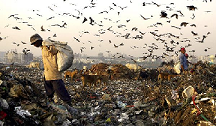
Landfill in Delhi (Source: image.businessweek.com)
What a waste !
We create an enormous amount of waste every single day. How do we quantify this ‘enormous amount’ ? Estimates on waste generation by an individual per day, varies with food habits, standard of living, geographical areas and even income levels. It is estimated that in urban areas our homes, schools and businesses churn out 57 million tonnes per year [1]. That amounts to roughly 500 grams/person/day, and incredibly this amount keeps going up every single day !

Future prediction of waste generation in India (Source: Bhide and Sundaresan 1983, EPTRI 1995)
Waste generated by the swelling numbers of humans on this planet is growing exponentially. Disposing of our garbage in landfills or burning it as fuel (waste to energy) is the final stage of treating our waste. Unfortunately landfills too have a limited life span, after which more land needs to be identified and used. This land crunch, along with stronger community lobbies against landfills around their homes (Not In My Backyard Syndrome, NIMBY), as seen recently in the Bangalore garbage crisis, worsens the mess.
The land required to dispose waste in an engineered landfill would be around 1.08 km2 every year [2].
| Year | Area of land required for MSW disposal (sq km) | City Equivalent |
| 1947-2001 | 240 | 50 % of Mumbai |
| 1947-2011 | 380 | 90 % of Chennai |
| 1947-2021 | 590 | Hyderabad |
| 2009-2047 | 1400 | Hyderabad + Chennai+ Mumbai |
Size of land projections required for future landfills (Source: Study by TERI, titled 'SWM in India: Options and opportunities [3])
Check out this waste-o- meter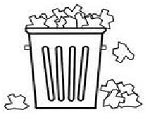
Did you know:
- that the average lifespan of a landfill site is 20 to 25 years ?
- that the per capita generation rate for municipal solid waste in a metro city is the highest for Chennai [4] [5] ?
- that 70 % of plastic consumption is converted as waste ?
Let’s trash this ’ Trash’
Waste, trash, garbage, no matter what we call it, the bottom line is that we are generating it in huge amounts and simultaneously using up immense raw material resources to produce it. We are today facing an onslaught of the growing garbage menace, which unfortunately does not have an easy, quick fix solution. But we can turn this problem on its head by treating waste as a resource itself. Recycling can turn many kinds of garbage into something useful !
Regardless of whether we convert waste paper into newsprint, kitchen left overs into compost, old clothes into bags, or reuse plastic items, we all benefit from recycling. That’s because it reduces the amount of garbage we have to get rid of, which in turn reduces the amount that needs to be buried in our already overcrowded landfills or burnt in incinerators. In addition, we save energy used to make new products, thus helping to conserve natural resources as well as cut down on pollution.
Source reduction
Recycling, burning and landfills are all post event actions. These are required after we have already created waste. A more straight forward method is to reduce our mountains of garbage before they become a problem. This approach is called "source reduction," and its aim is to reduce the amount of waste we create.
Here are 10 solutions to the crisis
Some solutions, both at the individual and community level are workable. The maximum impact will be felt, if change is initiated at the source stage itself, and that is where you and I come into the picture.
Below are some tips, we all can follow that will reduce the volume of waste reaching the landfill, thereby saving landfill areas and conserving resources that were used to process them:
- Bulk purchases: A bulk pack of laundry detergent contains up to 80 % less packaging than equivalent amount of detergent purchased in individual boxes. Buying things in concentrated form also helps cut down on packaging material used
- Refuse plastic bags at fast food restaurants or stores, when you only buy a few items
- Compost pile creation for grass clippings, tree trimmings and fruit and vegetable scraps that you generate at home
- Reuse items - use them over and over until they are completely worn out or make them into something else; use your own silverware, say no to plastic cutlery
- Borrow or share items you don't use very often
- Donate unwanted items to thrift stores or charitable organizations
- Repair items, instead of throwing away and buying new
- Refill bottles: Bring grocery store bags back and use the same ones the next time you go shopping
- Recycle all that you can, and that includes your newspapers, television sets, computers, tyres and old appliances. Choose goods with minimal and recyclable packaging
- Reduce your plastic footprint
We are using way too much stuff, much , much more than our share and definitely much more than our needs. We need to rethink of the legacy we want to leave for our future generations. We need to remember that we have not inherited this earth from our forefathers but simply borrowed it from our children. Let’s not destroy this trust but move ahead, questioning ourselves on our every whimsical purchase, reflecting on the waste we create and promising to use less of the trash can !
Talk to us
Is your neighbourhood bogged down by a garbage crisis ? Do you know a 'waste management warrior', who has campaigned for this cause and cleaned things up a bit ? Do join us, in this ‘trashy’ conversation by posting your experiences in the comments section below.
References
- Report to the people on Environment and Forests, Ministry of Environment and Forests, 2009-10
- Hazardous waste: Special reference to municipal solid waste management, Ministry of Environment and Forests, 2001
- Sustainable solid waste management in India, Columbia University, 2012
- Municipal solid waste management in Indian cities – A review, Waste Management Journal - Elsevier and Science Direct, 2007
- Quantities and waste generation rate in 59 cities, Central Pollution Control Board, 2004-05
Related Links
- Solid waste mangement in Delhi, City Development Plan, Jawaharlal Nehru National Urban Renewal Mission, 2010
- Manual on management of municipal solid waste, Central Pollution Control Board, 2007
- Material on plastic waste management, Central Pollution Control Board, 2012
- Solid waste management in Delhi - A social vulnerability study, Toxics Link, 2003
- Recycling livelihoods, GTZ, 2010
- Municipal solid waste management in India - Current state and future challenges : A review, International Journal of Engineering Science and Technology, 2012